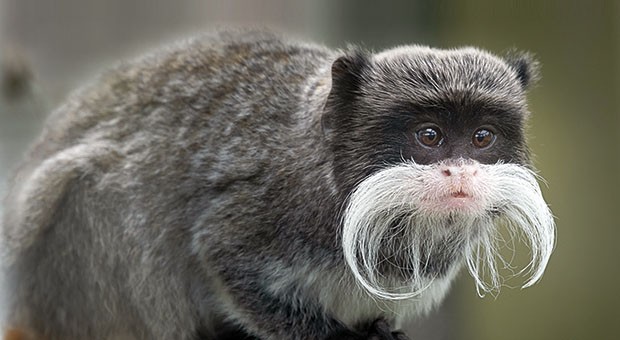Vive nella foresta amazzonica un primate dai lunghi baffi bianchi simili a quelli di Guglielmo II di Germania
I baffi più stilosi del regno animale appartengono senz'ombra di dubbio al tamarino imperiale, un primate platirrino della famiglia dei cebidi. L'appellativo “imperatore” gli venne dato inizialmente per scherzo, per via della somiglianza tra i suoi baffi e quelli dell'imperatore Guglielmo II di Germania, che era solito portarli lunghi e ripiegati verso l'alto; il nome piacque così tanto agli zoologi europei che diventò definitivo, non solo nel linguaggio comune ma anche nella nomenclatura ufficiale latina (Sanguinus imperator).
A differenza di quelli di Guglielmo II, però, i baffi del tamarino – in genere di colore bianco – sono rivolti verso il basso e arrivano fin sotto le spalle. Il tamarino imperatore è diffuso in una vasta area di foresta tropicale amazzonica compresa tra il Perù sud-orientale e il Brasile nord-occidentale, passando per la Bolivia settentrionale.
Vivendo in zone della foresta fino a poco tempo fa inaccessibili, la specie non è ancora considerata a rischio di estinzione, anche se il numero di esemplari in natura sta notevolmente diminuendo; negli ultimi tempi, infatti, la costruzione di strade si sta spingendo sempre più verso il suo habitat, rendendolo suscettibile alla deforestazione e allo sfruttamento per l'allevamento.
Senza contare che spesso vengono catturati per essere venduti come animali domestici.
La scimmia sud-americana colonizza indifferentemente le foreste pluviali e quelle alluvionali, che siano inondate o a fondo asciutto (tierra firme), resistendo fino ai trecento metri di altitudine.
Non solo, si adatta bene anche alle foreste cosiddette “secondarie”, ovvero ricresciute dopo che la foresta originaria è stata per qualche motivo rasa al suolo.
Primati... collaborativi
Esclusivamente diurno, il tamarino imperiale vive prevalentemente tra le chiome degli alberi e solo raramente si spinge negli strati più bassi della foresta. Generalmente condivide il proprio habitat con il tamarino dal dorso bruno, traendo vantaggi reciproci nel controllo del territorio e nell'avvistamento di eventuali predatori; una specie, infatti, risponde ai richiami di allarme dell'altra e viceversa. Il tamarino imperiale si nutre soprattutto di frutta e insetti; grazie al suo peso contenuto, che non supera mai il mezzo chilo, riesce a raggiungere anche i rami più sottili, dove animali dalla dieta simile ma di dimensioni maggiori non riescono ad arrivare.
In carenza di cibo è possibile che cacci anche piccoli vertebrati come lucertole, rane e uova di uccelli. Vive in gruppetti comprendenti tra i due e gli otto individui, comandati sempre da una femmina dominante, che si accoppia promiscuamente con tutti i maschi suoi subordinati.
I cuccioli vengono curati dai maschi sin dalla nascita, quando si occupano di leccare via la placenta e di stimolarli alla respirazione.
Per evitare che la madre - già provata per il parto - diventi troppo vulnerabile, per i primi due mesi di vita i papà portano i cuccioli sempre con sé, tenendoli sul dorso. Solo al terzo mese i cuccioli cominciano a muoversi autonomamente e ad assaggiare cibi solidi; dopo un anno e mezzo raggiungono la maturità sessuale e sono pronti ad allontanarsi dal gruppo natio, ma in genere non se ne separano prima dei tre anni.
I tamarini sono animali molto socievoli, amanti del gioco e delle coccole; in natura passano molto tempo a ripulirsi a vicenda dai parassiti e in cattività si affezionano al loro guardiano, nella cui mano amano giacere in attesa di carezze.
Laura Spataro

 Traduzione in lingua inglese a opera di ViceVersa Group
Traduzione in lingua inglese a opera di ViceVersa GroupA tamarin with an imperial mustache
A primate with a long white mustache, similar to that of William II of Germany, which lives in the Amazon rainforest
The most stylish mustache of the animal kingdom belongs without a shadow of doubt to the imperial tamarin, a platyrrhine primate of the cebid family. The appellative "emperor" was initially given to him as a joke, because of the similarity between his mustache and that of Emperor William II of Germany, who used to wear it long and twisted upwards at the ends; European zoologists liked the name so much that it became definitive, not only in common language but also in the official Latin nomenclature (Sanguinus imperator). Unlike that of William II, however, the tamarin's mustache - usually white in color - is turned downwards and reaches down under its shoulders.
The emperor tamarin is widespread in a large area of Amazonian tropical forest between south-eastern Peru and north-western Brazil, passing through northern Bolivia. Living in areas of the forest which until recently were inaccessible, the species is not yet considered endangered, even if the number of specimens in the wild is decreasing considerably; in fact, in recent times, road construction has been increasingly moving towards its habitat, making it susceptible to deforestation and exploitation for livestock breeding.
Not to mention the fact that tamarins are often caught to be sold as pets. The South American monkey colonizes both rainforests and alluvial forests, whether they are flooded or dry (tierra firme), able to survive up to three hundred meters above sea level. Not only that, it also adapts well to the so-called "secondary" forests, that is, regrown after the original forest was for some reason razed to the ground.
Collaborative... primates
Exclusively diurnal, the imperial tamarin lives mainly in the treetops and only rarely goes in the lower layers of the forest. Generally it shares its habitat with the brown-backed tamarin, drawing mutual benefits in the control of the territory and in the sighting of any predators; one species, in fact, responds to the alarm calls of the other and vice versa.
The imperial tamarin feeds mainly on fruit and insects; thanks to its low weight, which never exceeds half a kilo, it even manages to get up to the thinnest branches, where animals with a similar diet but larger in size are unable to go. In the absence of food, it may also hunt small vertebrates such as lizards and frogs or feed on bird eggs. It lives in small groups comprising between two and eight individuals, always led by a dominant female, who mates promiscuously with all her subordinate males.
Cubs are cared for by males since birth, when they take care of licking away the placenta and stimulating them to breathe. To prevent the mother - already exhausted from giving birth - from becoming too vulnerable, for the first two months of life dads always carry the cubs with them, keeping them on their backs. Only in the third month do the cubs begin to move independently and taste solid foods; after a year and a half they reach sexual maturity and are ready to move away from the native group, but generally they do not leave it before the age of three.
Tamarins are very sociable animals, who love games and cuddles; in the wild they spend a lot of time delousing each other and in captivity they become attached to their keeper, whose hand they love laying in waiting to be stroked.

 Bergamo - Via Maglio del Rame 19
Bergamo - Via Maglio del Rame 19

















